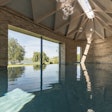


 Revival of the ancient Baths of Caracalla, founded in 212 A.D.
Revival of the ancient Baths of Caracalla, founded in 212 A.D.
Their wisdom has endured for 20 centuries, and flourishes today in our own understanding of water's salubrious properties that affect us on both a mental and physical level. Scientific studies have shown how we are attracted to blue for its calming effects and how water heals us through both consuming it (by drinking or eating) and bathing in it.
Consider how the structure of the swimming pool mirrors the human: how the heart and veins are like a pump and pipes. Both have means to filter and clean the circulating water. Both are literally bodies of water. It is this parallel structure that informs a pool design imperative that revolves around humans — what I call "water of body design."
This humanist concept is slowly inculcating design trends in Europe along with a minimalist approach. The standard economical blue-colored pool is becoming obsolete. Vessels are becoming the poetry of the place they live in, inserting themselves as a continuation of the landscape and an invitation for people to bathe and receive the gifts they offer. Especially for geographical inland areas — far from the sea or bathing lakes — the need to be near water transforms the quality of life. Therefore, local materials like natural stones or ceramics that take on the color or identity of the surroundings give a design that positively affects mind-body wellness. Certain liners are even mimicking natural stones with a 3D effect called "Touch." The human experience in water changes completely on both a physical and psychological level when the five senses are enhanced by a pool that tells the story of the place.
 An example of the pool speaking the poetry of the place: Suspended in the sky where blue meets blue, it also creates the metaphor of our reflection in water. Sorafurcia, BZ, Italy. Architect Lukas Rungger.Photo courtesy Piscine Oggi
An example of the pool speaking the poetry of the place: Suspended in the sky where blue meets blue, it also creates the metaphor of our reflection in water. Sorafurcia, BZ, Italy. Architect Lukas Rungger.Photo courtesy Piscine Oggi
It's important to note that the key element to wellness pool design is detail: for example, a slim cut in a pool border lined with natural stone or ceramic that acts as an overflow, allowing form to dominate function. Delicate and subtle features like waterfalls, enhancing the calming element of sound, accent the pool without being ostentatious. Landscaping local plants that become part of the vessel's scenery represents how good a person feels after a swim and a walk in nature. Lastly, the element of light is a detail that should never be overlooked, as it stimulates the senses during an evening swim: The play of colors on the water offers the opportunity to engage in the sensory experience of sight, sound, and touch.
 Biopools (by Platter Biopools) integrate natural stones and local plants to capture the essence of the surroundings.Photo courtesy Piscine Oggi
Biopools (by Platter Biopools) integrate natural stones and local plants to capture the essence of the surroundings.Photo courtesy Piscine Oggi
The new nature of pool design reflects human design and the need to create an environment that maximizes our relationship with water. Whether it becomes a center of social interaction in a private home or recreational center, the context needs to invite the user to have a sensory experience that inspires the mind and enhances the body. We come back to our origins in water both historically and biologically where we feel at home and at peace with ourselves while feeling the health benefits in a holistic way. This is truly the goal of water wellness design.
This article first appeared in the October 2024 issue of AQUA Magazine — the top resource for retailers, builders and service pros in the pool and spa industry. Subscriptions to the print magazine are free to all industry professionals. Click here to subscribe.












































